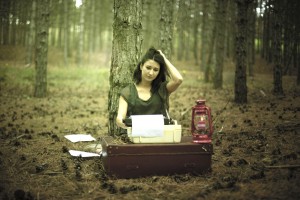 Keen observation enriches every writer’s prose. We’ve talked about how detail brings prose to life by bringing readers into the story. As a reminder, saying something is beautiful or sad doesn’t count as detail. You need to get specific, so readers can see the movie you’re filming through your words for themselves.
Keen observation enriches every writer’s prose. We’ve talked about how detail brings prose to life by bringing readers into the story. As a reminder, saying something is beautiful or sad doesn’t count as detail. You need to get specific, so readers can see the movie you’re filming through your words for themselves.
Check out how Wally Lamb introduces a young woman named Velvet in his novel The Hour I First Believed, giving us tremendous insight into both her and his narrator in the process:
Remembering that our dogs freaked her out, I grabbed them by their collars. “Got ’em!” I called. The phrase “all bark, no bite” could have been coined for our mutts: couple of wimps, those two. But to tell you the truth, it was a relief to see Velvet afraid of something. Eyeing my hold, she entered the yard in full freak regalia: halter top, exposed flab, hacked-off tuxedo pants, and those Bozo-sized men’s workboots of hers, spray-painted silver. Her shaved head had grown out in the months I hadn’t seen her. Now she was sporting a butch cut, dyed bread-mold blue. Watching her make a beeline for the picnic table, I couldn’t help but crack a smile. Short and squat, she moved like R2-D2. She climbed from the bend to the tabletop and fumbled for a cigarette. Having secured higher ground and sucked in a little nicotine, her cocky stance returned.
In a single paragraph studded with descriptions like Velvet’s “bread- mold blue” butch haircut, Lamb’s character has jumped off the page and into my lap, and I feel like I need to spray myself with sanitizer.
Where do you get those kinds of mood-setting characterizations and details? From the people and locales of your book if you’re writing nonfiction and your own life and surroundings if you’re inventing a world.
My writing coach client and friend Wendy Coblentz, author of It’s Your Fault: My Journey through Back Pain, a Teenager and Self-Discovery, records snatches of conversations she takes part in or overhears at the market, at restaurants, at home and everywhere in between. As a result, her dialog sounds authentic because it is authentic.
Sometimes you can’t rely on pure observation. When I was helping a friend’s sister revise her historical romance, I researched the dress, furnishings and even the mannerisms of the period so the novel would ring true. Even so, I humanized these Regency-era folk with details I picked up just by paying attention to my thoroughly modern friends and family.
Simple yet studied observation of the world around you can yield not just details but insights. When a writing coach client needed to beef up his character descriptions, I sent him to the mall to observe how people dressed, moved and interacted. His scrutiny earned him more than a few confused and suspicious looks, but he returned armed with a new lexicon of detail and characterization he could use to bring the characters in his novel to life. “I just never paid attention before,” he said.
Bingo!


Sorry, comments are closed for this post.